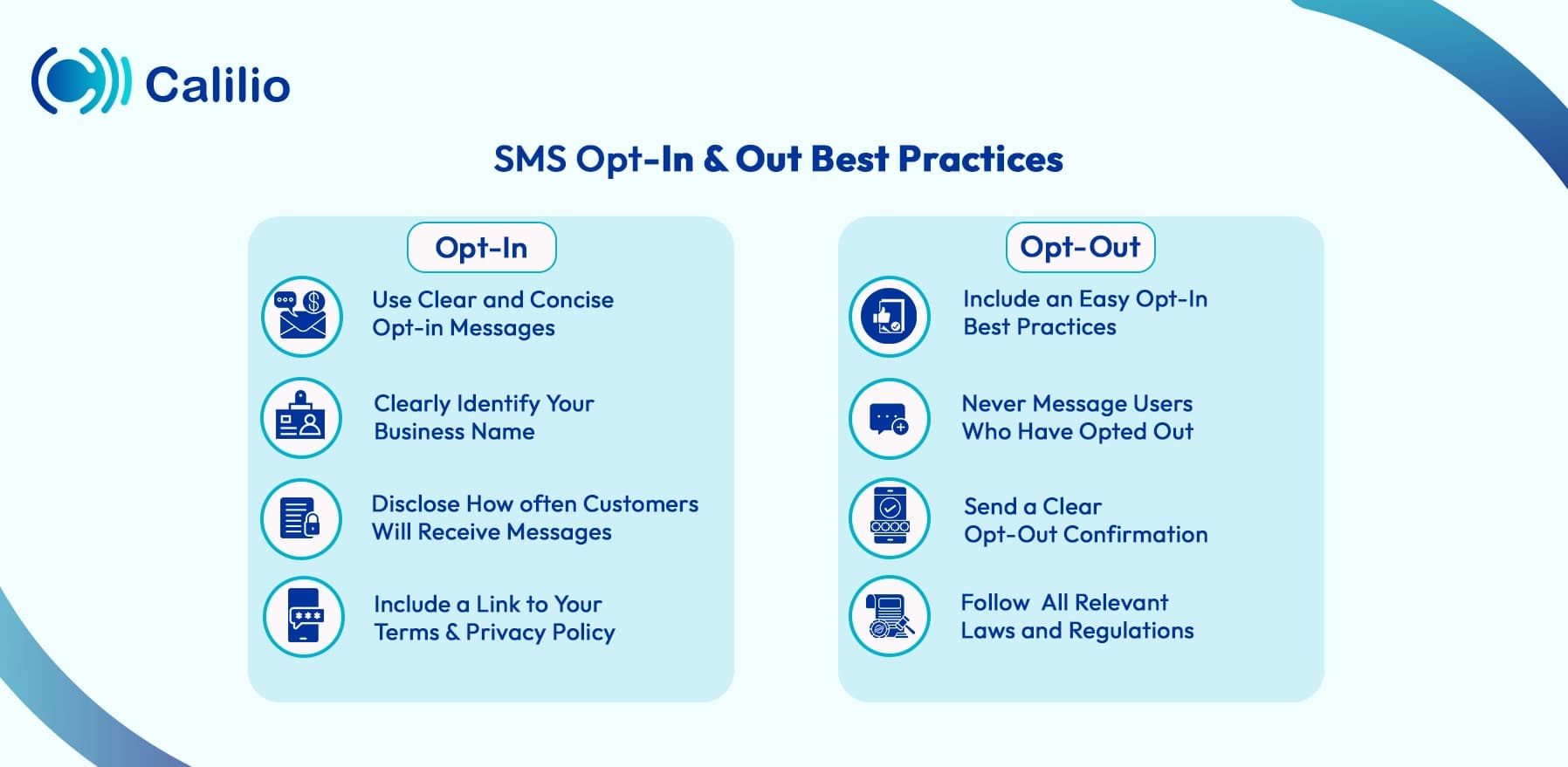Opt-in and Opt-out in Text Messaging: Explained

Text messaging is a great way for businesses to reach their audience. But for many recipients, getting unexpected marketing texts can feel intrusive, especially when they didn’t knowingly sign up for them or don’t know how to stop them.
From a customer’s perspective, it can feel frustrating, while for businesses, sending unwanted texts can result in legal penalties and lost trust.
That’s where opt-in and opt-out come in. These processes empower users to control their inbox while helping businesses stay compliant. In this article, we’ll explore what opt-in and opt-out mean in texting and how businesses can avoid sending automated text messages without permission.
Keep reading!
Key Highlights:
Opting in or out of texting means choosing whether to receive or stop receiving messages, giving users full control over SMS communication.
Opt-in is the user’s explicit consent to receive texts, while opt-out is a legal mechanism to stop them immediately.
Businesses rely on it to follow laws like TCPA/GDPR, avoid fines, and build trust through permission-based messaging.
Consent for texting is collected through clear methods such as text keywords, website checkboxes, QR codes, or verbal agreements.
The best practices for opt-in and opt-out text messages include clearly identifying your business, disclosing message frequency, and providing an easy opt-out process.
What Does ‘Opt’ Mean in Texting?
In texting, "opt" refers to the action of choosing whether or not you want to receive messages, especially from organizations or businesses. When you opt in, you’re allowing businesses to send you messages and agree to stay subscribed to updates or offers. On the other hand, ‘opt-out’ means you are choosing to stop receiving those messages and unsubscribe from future communications.
This SMS marketing practice ensures that companies only text people who want their messages, keeping communication relevant, legal, and respectful. It also provides recipients with full control over the text messages they want to receive.
What Does Opt-in Mean in Texting?
A customer opting in means they have agreed to receive a message from a sender, usually by replying to a consent text with a keyword or filling out a web form. After opting in, the customer is added to a list that will send them future messages, updates, promotions, or notifications, typically from businesses, organizations, or marketing campaigns.
This process helps businesses stay TCPA-compliant and avoid sending unsolicited messages.
Example of Opt-in Message:
"Reply 'YES' if you’d like to receive exclusive updates."
In this case, replying "YES" signifies explicit SMS opt-in, meaning you’re choosing to receive future promotional messages.
Why Do Businesses Use Opt-in in Texting?
By obtaining the customer’s permission, businesses comply with legal regulations, build customer trust, and improve engagement.
- Legal Compliance with TCPA and GDPR
Laws like the Telephone Consumer Protection Act (TCPA) in the U.S. and the General Data Protection Regulation (GDPR) require businesses to gain clear user consent before sending marketing texts. Violations of the law can result in fines or lawsuits. A message like “Text YES to join our list” satisfies the compliance requirement. - Building Customer Trust
Asking for consent before sending the message shows respect for customer preferences. This mutual agreement and transparency help businesses build trust and establish a respectful relationship with their audience. - Boosting Engagement
Opted-in users are more likely to engage, as they willingly signed up to receive the messages. This lets you send messages to people who are genuinely interested in your products or services, leading to higher engagement.
How Do Businesses Ask for Opt-in Consent?
Businesses ask for opt-in consent through multiple methods: Text-to-Join Keywords, Website Forms, QR Codes, Verbal, and Checkout Opt-Ins. Each method includes a clear opt-in message, asking recipients' permission to send marketing or promotional messages.
- Text-to-Join Keywords
Businesses often send customers initial opt-in text messages asking them to text a keyword (like “JOIN” or “DISCOUNT”) through a short code. If the customer replies with the keyword or the same text, they are confirming that they’re okay to receive future messages from the business.
- Website Forms
On websites, businesses may include an option to opt in for text messages, often with a checkbox that customers can tick to agree. This is commonly seen during account creation or when signing up for a newsletter.
- QR Codes
Some businesses use QR codes in print or on websites. Scanning the code leads customers to a page where they can subscribe to SMS updates.
- Verbal Opt-Ins
Sometimes, businesses may ask customers directly (in person or over the phone) if they'd like to receive text updates. If the customer agrees, the company records their consent and adds them to the text list.
- Checkout Opt-Ins
Many businesses prompt customers, either online or in-store, to opt in for text messages during the checkout process. This can be done by asking them to check a box, which is often confirmed via a follow-up text.
What Does Opt-out Mean in Texting?
Opting out means that a customer has chosen to stop receiving messages from a business or organization, such as marketing or promotional texts. When someone opts out, they are withdrawing their consent to receive texts and unsubscribing from future communications.
This option is often included in automated or mass text messages to follow privacy laws and give recipients control. Once someone opts out, they are typically removed from the sender’s contact list and should no longer receive texts from that source.
Example of Opt-Out Message:
"If you no longer want to receive our updates, simply text 'STOP'”.
In this case, replying STOP will immediately remove you from the business SMS list and stop further messages.
Why Would Customers Want to Opt Out?
Customers opt out if they feel overwhelmed by too many messages, receive irrelevant content, or want to protect their privacy. After completing a purchase, further messages may seem unnecessary, leading them to unsubscribe from the SMS.
- Too Many Texts: If customers feel overwhelmed by the messages they receive, they might opt out to reduce the clutter.
- Irrelevant Content: If the messages no longer relate to the customer’s interests or needs, the customer may choose to stop receiving the texts.
- Privacy Concerns: Some customers may want to protect their privacy and limit the number of companies they interact with via text.
- After a Purchase: Once the customer has completed their intended transaction, further messages may feel unnecessary or excessive.
Stay Compliant and Connected with Calilio
Send SMS opt-in and opt-out messages—keep your campaigns on the right side of the law.
What are the Best Practices for Opt-in and Opt-out in Texting?
Opt-in best practices include clearly identifying your business, disclosing message frequency, and providing a link to your privacy policy. For opt-out, ensure an easy unsubscribe option, send a confirmation message, and remove users promptly from your list once they choose to stop receiving the message.
To stay compliant, also make sure to follow messaging laws like A2P 10DLC and TCPA for both processes.
SMS Opt-In Best Practices:

- Use Clear and Concise Opt-in Messages: Ensure that your opt-in message is easily understandable to your recipients.
- Clearly Identify Your Business Name: Include your brand name clearly in each SMS to build recognition and trust. This will prevent your texts from being flagged as spam.
- Disclose How Often Customers Will Receive Messages: Let customers know how often they’ll receive messages before they opt in. Being upfront about message frequency helps manage expectations and reduces the chances of users feeling overwhelmed.
- Include a Link to Your Terms and Privacy Policy: Include a link to your terms and privacy policy in your messages or forms. It allows users to review how their information will be used and shows that your business values transparency.
SMS Opt-out Best Practices:
- Include an Easy Opt-out Process: Make opting out fast and easy by including a clear unsubscribe option in every message.
- Never Message Users Who Have Opted Out: Never send messages to anyone who has opted out. Once someone unsubscribes, remove them from your list immediately to maintain trust and stay legally compliant.
- Send a Clear Opt-out Confirmation: Always send a confirmation message after a user opts out. It reassures them that their request was successful and shows that you take their preferences seriously.
- Follow All Relevant Laws and Regulations: Ensure your opt-out practices comply with relevant data protection laws, such as the GDPR and TCPA. Additionally, if your business is related to the health industry, use a HIPAA-compliant messaging system.
Conclusion
Understanding what opt-in and opt-out mean in texting is essential for maintaining effective and respectful communication. It empowers customers to control what they receive in texts while protecting businesses from legal risks and reputational damage.
By implementing the opt-in and opt-out best practices, businesses can reach only those who genuinely want to hear from them. Whether you're sending updates or promotional content, the right opt-in and opt-out strategy turns SMS into a valuable, consent-driven communication channel.

Get Cashbacks Up to 43% Straight To Your Wallet!
Unlimited Virtual Numbers – Local, Mobile & Toll-Free from 100+ Countries
Free Local Phone Number from US or Canada
Crystal-Clear Calls Starting at Just $0.0153/min
24/7 Human Support – Because Great Service Never Takes a Holiday


Frequently Asked Questions
How can I tell if a text message is from a legitimate business or a scam?
To determine if the message is legitimate or a scam, look for clear brand identification, opt-out instructions, and a consistent sender number. Scam messages often feel vague or rushed and ask for personal information without context.
Why do I still receive texts from companies even after unsubscribing?
Is it safe to provide my phone number for SMS updates?
Can I customize what types of messages I receive by opting in?
How can I opt back in after opting out of text messages?

Still have questions?
Can’t find the answer you’re looking for? Please chat with our friendly team.
Stay in the loop
Get the latest call insights, trends, and updates delivered straight to your inbox.
By subscribing, you agree to receive updates from Calilio.
You can unsubscribe anytime.